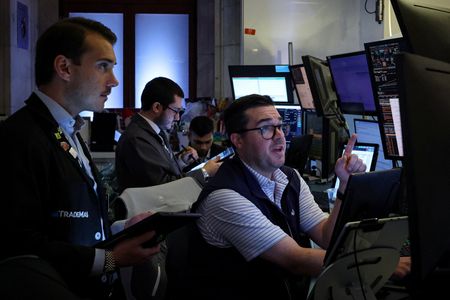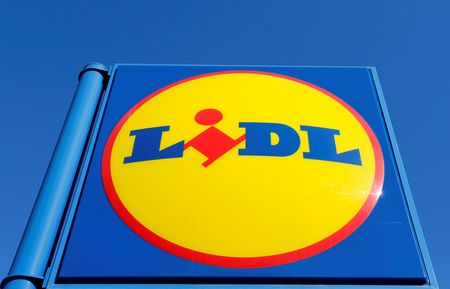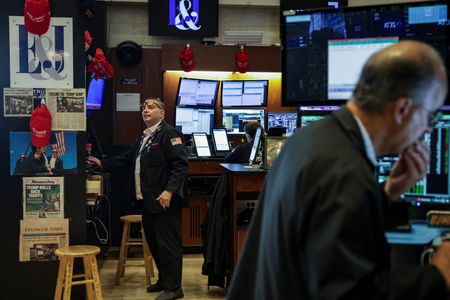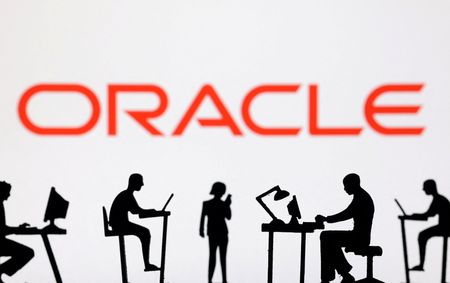By Jamie McGeever
ORLANDO, Florida (Reuters) -TRADING DAY
Making sense of the forces driving global markets
By Jamie McGeever, Markets Columnist
A surprise spike in U.S. producer price inflation took the wind out of stock markets’ sails on Thursday and prompted investors to reassess their view that an interest rate cut next month was a near certainty.
More on that below. In my column today I look at five charts that show the foundations underpinning the U.S. economy and Wall Street may be shakier if you strip out the AI- and tech-related spending.
If you have more time to read, here are a few articles I recommend to help you make sense of what happened in markets today.
1. Trump’s data war risks creating false calm: Mike Dolan 2. Fed hawks and doves: what U.S. central bankers aresaying 3. Trump’s debanking order could create headaches forbanks, sources say 4. Trump says Putin ready to make deal on Ukraine, U.S.hopes to include Zelenskiy 5. Which Donald Trump will negotiate with Putin in Alaska?
Today’s Key Market Moves
* STOCKS: The Russell 2000 falls 1.3% but the S&P 500,Nasdaq and Dow basically end flat. Indeed, the S&P 500 manages anew closing high. * SHARES/SECTORS: Seven sectors in the S&P 500 fall, ledby industrials and materials, off around 0.9%. Fashion retailerTapestry sinks 15% on tariff, profit warning. * FX: Dollar rebounds around 0.5% for its best day in twoweeks. Biggest G10 FX move is New Zealand dollar, down 1%. * BONDS: Treasury yields rise as much as 5 bps. Curvesbarely move, but 2s/30s still close to steepest levels in threeyears around 115 bps. * COMMODITIES: Oil spikes around 2%, its biggest rise intwo weeks.
Today’s Talking Points:
* The Fed outlook. Rates traders trimmed the probability of a quarter-point rate cut next month to 90% from 100% after the release of July’s producer price inflation data. Core annual PPI shot up to 3.7%, the highest in three years. Excluding pandemic distortions, the jump from June’s 2.6% was the biggest since comparable data was first gathered in 2011.
Talk of a 50-basis point cut next month, partly fueled by Treasury Secretary Scott Bessent on Wednesday, has evaporated. The PPI data ensured that, but Bessent also rowed back a bit on Thursday. Another couple of solid inflation and employment reports, and could a September cut be taken off the table completely?
* European GDP. The first estimate of Q2 UK growth was released on Thursday and broadly speaking, the 0.3% expansion was better than expected – or not as bad as feared, depending on your view. Indeed, Britain’s economy grew nearly twice as fast as the U.S. economy in the first half of the year.
Euro zone GDP was less stellar, with a slump in industrial production in June and downward revision to May capping overall GDP growth in the April-June period at just 0.1%. That marked a clear slowdown from 0.6% expansion in the first quarter.
The elephant in the room, of course, is the impact of tariffs, which has yet to be fully felt, suggesting the second half of the year is likely to be bumpier than the first.
* Do you want to make a deal? Donald Trump and Vladimir Putin meet in Alaska on Friday, with the U.S. President saying his Russian counterpart is keen to “make a deal” on Ukraine. The aim of Friday’s talks is to set up a second meeting including Ukraine, and perhaps agree the framework for a ceasefire.
Despite his harsher tone toward Putin over the past months, Trump has a long history of trying to placate the Russian leader. The Trump administration has sought to temper expectations, and White House press secretary Karoline Leavitt told reporters on Tuesday the meeting would be a “listening exercise.”
That’s probably not what Ukrainian President Volodymyr Zelenskiy wants to hear.
The U.S. economy’s key weak spots in five charts
The U.S. economy seems to be chugging along fairly smoothly, if a little too slowly for some observers’ liking. Under the bonnet, however, the picture is more worrisome, and the risk of engine malfunction is rising.
Technology’s role in the U.S. economy has never been greater, and artificial intelligence could deliver a historic productivity boom. But return on the huge investment being made on that bet could take years to materialize. What’s more, an unbalanced economy may not be desirable in the long term, as it can lead to poor investment and policy decisions.
Below are five charts that indicate the foundations of the resilient U.S. economy and booming stock market may be much shakier than they appear, especially if AI- and tech-related spending, investment and optimism are stripped out.
INVESTMENT
Inflation-adjusted investment in ‘AI-sensitive’ sectors of the economy since the end of 2019 has risen 53%, notes Troy Ludtka, senior U.S. economist at SMBC Nikko Securities. Investment elsewhere has inched up just 0.3%.
CONTRIBUTION TO GDP
Relatedly, the contribution of software and IT equipment capex to U.S. GDP has never been higher, according to analysts at BlackRock. Aggregate capex in all other areas of the economy, however, actually fell in the first half of this year – a rare occurrence.
CONSUMER SPENDING
Meanwhile, personal consumption expenditures are slowing sharply, a worrying sign given that the consumer accounts for around 70% of total U.S. GDP. Personal consumption expenditures in the second quarter grew by only 0.9%, the slowest pace since the pandemic. And in real terms, consumer spending has completely flat-lined in the first half of the year.
CORPORATE BANKRUPTCIES
Corporate bankruptcies in July were the highest for a single month since July 2020, according to S&P Global Market Intelligence. Even more alarming, the tally of year-to-date bankruptcy filings through the end of July was the highest for this seven-month period since 2010. Nearly a third of this year’s bankruptcies were in the consumer discretionary and industrial sectors.
STOCK MARKET CONCENTRATION
Finally, the concentration on Wall Street has been widely discussed, but the levels continue to be eye-popping. One stock, chipmaker Nvidia, accounts for 8% of the benchmark S&P 500’s entire market cap. That’s a record for a single name.
And the top 10 stocks, most of which are Big Tech megacaps, make up 40% of the index’s market cap and 30% of all earnings. These are also record levels.
The more Wall Street – and even global markets – rely on the revenue, earnings and profitability of a set of companies that can be counted on two hands, the bigger the potential mess could be if the trends driving these companies’ performance lose momentum.
What could move markets tomorrow?
* China “data dump” including investment, retail sales,industrial production, house prices, unemployment (July) * Japan GDP (Q2) * Taiwan GDP (Q2, revised) * Hong Kong GDP (Q2, final) * U.S. retail sales (July) * U.S. industrial production (July) * U.S. New York Fed manufacturing (July) * U.S. University of Michigan inflation expectations andconsumer sentiment (August, prelim) * U.S. President Donald Trump and Russian President VladimirPutin summit in Anchorage, Alaska.
Want to receive Trading Day in your inbox every weekday morning? Sign up for my newsletter here.
Opinions expressed are those of the author. They do not reflect the views of Reuters News, which, under the Trust Principles, is committed to integrity, independence, and freedom from bias.
(By Jamie McGeever; Editing by Nia Williams)










